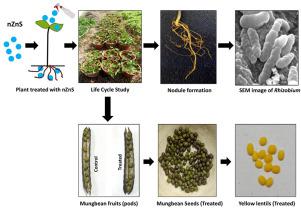NanoImpact ( IF 4.9 ) Pub Date : 2022-11-26 , DOI: 10.1016/j.impact.2022.100440 Mala Thapa 1 , Raghunath Sadhukhan 2 , Abhishek Mukherjee 3 , Prasanta Kumar Biswas 4

|
Scarce of knowledge of using Zinc (Zn) nanoparticles (NPs) to augment plant growth, Zn availability to plants and its potential toxicity warrants more NPs–plant life cycle studies. The main objectives of this study were to compare nano zinc sulphide (nZnS) with nano zinc oxide (nZnO) and ionic Zn i.e., ZnCl2, as a source of Zn, as well as to establish physiological impact of NPs on growth, yield and symbiosis of mungbean [Vigna radiata (L.) R. Wilczek] plants at different concentrations (0, 0.01, 0.1, 1 and 10 mg kg−1 of soil). In this study, mungbean plants were grown for 60 days (life cycle study) in natural soil infested with Bradyrhizobium. Effects of Zn compounds (nZnS, nZnO and ZnCl2) on plant height, dry biomass, number of nodules per plant, yield and fruit agronomical parameters along with micronutrient assessment were determined. Impact of Zn compounds on Bradyrhizobium–mungbean symbiosis was also unravelled. Results showed that both the NPs, (nZnS and nZnO) were more effective than ZnCl2 in promoting growth and yield up to a critical concentration and above which phytotoxic effects were observed. Both the NPs were more effective than ZnCl2 at increasing fruit Zn content also. Whereas, nZnS treatment was found to be better than nZnO in improving overall plant growth. Bradyrhizobium–mungbean symbiosis was not affected at lower NPs concentrations, while higher concentration revealed toxicity by damaging bacterial morphology and nodule formation. There was no nano specific toxicity found while, ZnCl2 showed relatively more toxicity than both the NPs. The present investigation demonstrated the concept of nano-micronutrient as well as NPs phytotoxicity by understanding NPs–plant interactions in the soil environment.
中文翻译:

nZnS 与 nZnO 和 ZnCl2 对绿豆 [Vigna radiata (L.) R. Wilczek] 植物和缓生根瘤菌共生的影响:生命周期研究
对使用锌 (Zn) 纳米粒子 (NP) 促进植物生长、Zn 对植物的有效性及其潜在毒性的了解不足,需要进行更多的 NPs-植物生命周期研究。本研究的主要目的是比较纳米硫化锌 (nZnS) 与纳米氧化锌 (nZnO) 和离子 Zn,即 ZnCl 2作为 Zn 的来源,并确定 NPs 对生长、产量和生长的生理影响绿豆 [ Vigna radiata (L. ) R. Wilczek] 植物在不同浓度(0、0.01、0.1、1 和 10 mg kg −1土壤)下的共生。在这项研究中,绿豆植物在感染了缓生根瘤菌的天然土壤中生长了 60 天(生命周期研究)。锌化合物(nZnS、nZnO 和 ZnCl 2) 确定了植物高度、干生物量、每株植物的根瘤数、产量和果实农艺参数以及微量营养素评估。还阐明了锌化合物对慢生根瘤菌- 绿豆共生的影响。结果表明,两种 NP(nZnS 和 nZnO)在促进生长和产量方面比 ZnCl 2更有效,达到临界浓度和高于该浓度时观察到植物毒性作用。在增加果实锌含量方面,这两种 NP 都比 ZnCl 2更有效。然而,发现 nZnS 处理在改善整体植物生长方面优于 nZnO。缓生根瘤菌–绿豆共生在较低的 NPs 浓度下不受影响,而较高的 NPs 浓度则通过破坏细菌形态和结节形成来揭示毒性。没有发现纳米特异性毒性,而 ZnCl 2显示出比两种 NPs 相对更大的毒性。本研究通过了解土壤环境中的 NPs-植物相互作用,证明了纳米微量营养素的概念以及 NPs 的植物毒性。



























 京公网安备 11010802027423号
京公网安备 11010802027423号